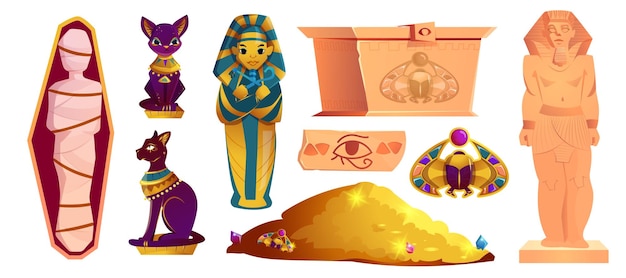Ancient Egypt Religion – Uncovering Fascinating Facts

Ancient Egypt religion was deeply ingrained in every aspect of daily life.
The ancient Egyptians believed in an afterlife and spent their lives preparing for it.
The religion of ancient Egypt was polytheistic, with a multitude of gods and goddesses.
One of the most important gods in ancient Egypt was Ra, the sun god.
The ancient Egyptians believed in the concept of ma’at, which represented order, justice, and truth.
The pharaohs of ancient Egypt were considered to be the living embodiment of the gods on earth.
The ancient Egyptians worshipped their gods through rituals and offerings.
The Nile River held significant religious importance in ancient Egypt.
The goddess Isis was a widely worshipped deity in ancient Egypt and was associated with motherhood and fertility.
Ancient Egyptians believed in the power of amulets and charms to protect them from evil spirits.
The ancient Egyptians built magnificent temples as sacred places for religious rituals and ceremonies.
The Book of the Dead was a collection of spells and prayers that ancient Egyptians believed would help them in the afterlife.
The ancient Egyptians believed in the existence of multiple souls within a person.
The worship of animal gods, such as the falcon-headed god Horus, was prevalent in ancient Egypt.
The ancient Egyptians believed in the importance of mummification to preserve the body for the afterlife.
Ancient Egypt Religion – Uncovering Fascinating Facts part 2
The deity Anubis was often depicted as a jackal-headed god and was associated with mummification and the afterlife.
The ancient Egyptians had a complex pantheon of gods and goddesses, each with their own unique roles and responsibilities.
The pharaoh Akhenaten attempted to introduce monotheism in ancient Egypt but was largely unsuccessful.
The ancient Egyptians believed in the existence of evil spirits and demons that could cause harm in both the living and the afterlife.
The god Thoth, often depicted as an ibis or a baboon, was associated with writing, wisdom, and magic in ancient Egypt.
Ancient Egyptians believed that the celestial bodies, such as the sun, moon, and stars, were manifestations of their gods and goddesses.
The worship of the god Osiris was intertwined with the concepts of death, resurrection, and the afterlife in ancient Egypt.
The annual flooding of the Nile River was seen as a divine blessing by the ancient Egyptians and was celebrated as a religious event.
The ancient Egyptians believed that their pharaohs would become gods after death and ruled over the afterlife.
The god Seth, associated with chaos and disorder, was both feared and worshipped in ancient Egypt.
Ancient Egyptians believed in the power of spells and incantations to invoke the assistance of their gods and goddesses.
The concept of divine kingship was central to the religion of ancient Egypt.
The ancient Egyptians held festivals and ceremonies throughout the year to honor and appease their gods.
The goddess Bastet, often depicted as a lioness or domestic cat, was associated with protection, fertility, and the home in ancient Egypt.
The ancient Egyptians believed that the heart played a vital role in the afterlife judgment process.
The worship of the goddess Hathor, associated with love, beauty, and motherhood, was widespread in ancient Egypt.
The ancient Egyptians believed that their gods had human-like characteristics and emotions.
The god Ptah, known as the creator god, was highly revered by ancient Egyptians.
Ancient Egypt religion included the belief in various underworlds and realms in the afterlife.
The ancient Egyptians practiced divination and believed in the power of oracles to foretell the future.
The goddess Ma’at, associated with truth and justice, was often depicted with an ostrich feather on her head.
The worship of the god Sobek, depicted as a crocodile, was prevalent in ancient Egypt, especially in regions with crocodile populations.
Ancient Egyptians believed in the existence of guardian deities who protected specific locations, such as temples and tombs.
The goddess Taweret, often depicted as a pregnant hippopotamus, was associated with childbirth and protection in ancient Egypt.
Ancient Egyptians believed that the world was created through the interaction of gods and goddesses.
The god Amun, often depicted as a ram-headed deity, was considered the king of the gods in ancient Egypt.
The ancient Egyptians practiced ancestor worship, believing that deceased family members could provide guidance and protection.
The worship of the god Sobek, depicted as a crocodile, was prevalent in ancient Egypt, especially in regions with crocodile populations.
Ancient Egyptians believed in the concept of divine intervention in their daily lives.
The religion of ancient Egypt had a profound influence on Egyptian art, architecture, and culture as a whole.

